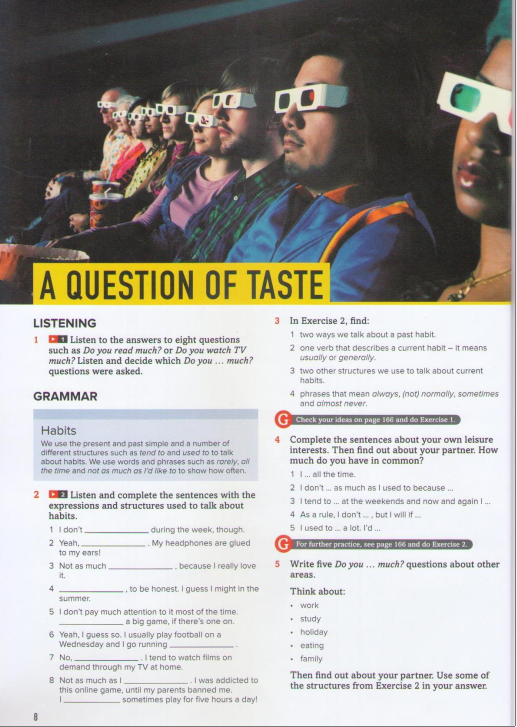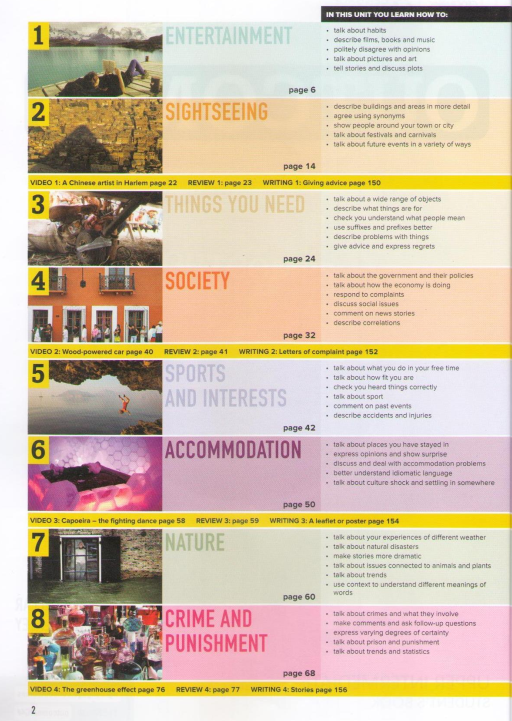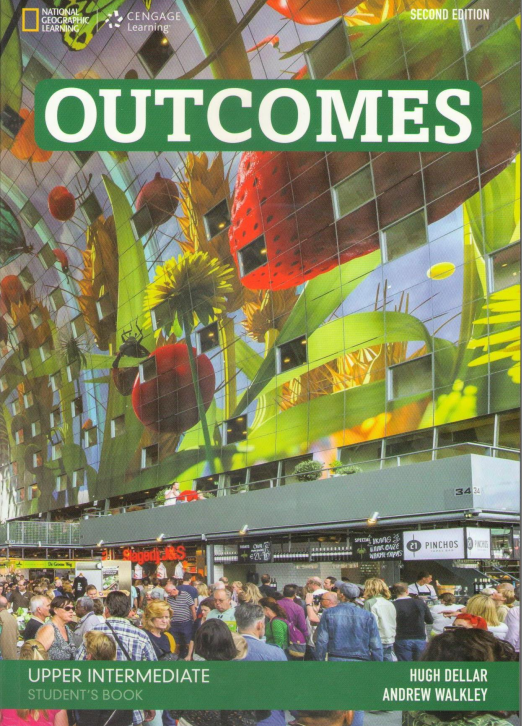


Mục lục
ToggleVOCABULARY Describing films, music and books
When we describe things, we often use pairs of adjectives that have similar meanings to emphasise what we mean.
We sometimes repeat the same adverb with each adjective.
It’s very moving – just very, very sad.
It’s great, absolutely amazing.
6 Complete the sentences with these words.
awful • disturbing • hilarious • uplifting • catchy • dull • over-the-top • weird • commercial • gripping
- It does nothing for me. It’s quite boring, quite ________.
- It’s one of those tunes that’s very easy to remember – very ________.
- It’s ________ – just really, really funny.
- It didn’t do much for me. It’s typical big-budget Hollywood – very ________.
- I can’t explain it. It’s really strange – really ________.
- It’s just too much for my liking – really ________.
- You can’t stop reading. It’s so exciting, so ________!
- It’s good, but it’s quite upsetting – quite ________.
- It’s a really inspiring story, really ________.
- Don’t go and see it! It’s dreadful, absolutely ________.
PRONUNCIATION
7 Listen to the sentences from Exercise 6. Notice when you stress the adverb. Repeat the sentences.
8 Write at least two words or phrases that you associate with each adjective in the box in Exercise 6.
awful – leave before the end | I hate | waste of money
9 Tell a partner the words you thought of. Your partner should guess the adjective.
LISTENING
10 Listen to two people talking about films and decide which statement is true.
- They agree on everything.
- They agree on most things.
- They don’t agree on very much.
- They don’t agree on anything.
11 Take notes about the two speakers to answer these questions. Listen again to check.
- Do they go to the cinema much?
- What kind of films are they mainly into?
- Have they seen any films recently?
- What did they think of them?
DEVELOPING CONVERSATIONS
Disagreeing politely
You heard the speakers disagree with viewpoints like this:
Yeah, I guess, but to be honest, I’m not that keen on action movies.
It was all a bit too weird for my liking.
As I say, it’s not really my kind of thing.
The Hunger Games was well-made / not bad, I suppose, but …
When disagreeing with someone’s tastes, instead of saying directly I don’t like it or it’s really weird, we often soften our responses by using phrases such as I’m not that keen on, I guess, I suppose, to be honest, for my liking, etc.
We also use a bit to soften negative adjectives.
12 Look at three short conversations. Soften B’s responses using some of the ideas above.
1
A: I’m really into 60s music. The Beatles, The Stones, stuff like that.
B: Yeah? I don’t like it. It’s the kind of stuff my dad listens to.
2
A: Do you like Tarantino? I love his films.
B: He’s all right, but I’m not keen on his films. They’re very over-the-top.
3
A: Have you ever read any Paulo Coelho? His books are fantastic.
B: I’ve read one. It was OK, but it didn’t do much for me.
PRONUNCIATION
13 Listen to the example conversations. Notice the stress and intonation. Repeat them.
14 Write some responses to these sentences, disagreeing politely. Practise them in pairs.
- I love Harry Potter and stuff like that.
- I’m really into opera. It’s fantastic.
- I love any reality TV show.
CONVERSATION PRACTICE
15 Work in pairs. Have conversations about your habits using the guide below. Then swap roles.
Ask question: Do you read / listen to music / go to the cinema / watch TV much?
Ask follow-up question: What kind of stuff are you into?
Have you ever seen / read …?
Answer, giving as full an answer as possible.
What other things do you read / watch? etc.
Don’t you find it a bit …?
etc.
SPEAKING
1 Read the quotations about art. Then discuss in pairs what you think each quotation means. How far do you agree with each one? Explain why.
- Art is the lie that enables us to realise the truth.
- Modern art = I could do that + Yeah, but you didn’t.
- Advertising is the greatest art form of the 20th century.
- Art is what you can get away with.
- The urge to destroy is also a creative urge.
- The more minimal the art, the longer the explanation.
- Art never responds to the will to make it democratic; it is not for everybody, it is only for those who are willing to undergo the effort needed to understand it.
VOCABULARY Talking about pictures
2 Look at the painting below. With a partner, discuss who the character might be and what you think is happening.
(Hình người đàn ông đứng trên vách đá nhìn ra biển)
3 Read the definitions. Discuss which adjectives could describe the painting above.
- Bold colours are very bright, strong and clear, whereas subtle colours are not strong or bright. They’re softer and more delicate.
- If a painting is conventional, it’s traditional and not new or different in any way.
- If a painting is dramatic, it contains a lot of exciting action and strong emotions.
- If it’s atmospheric, a painting creates a special mood – such as a feeling of mystery or romance.
- Abstract paintings don’t show artist’s feelings or thoughts, whereas realistic paintings represent people, objects or events.
- If it’s ambiguous, the meaning of the work isn’t clear or it’s open to interpretation.
- An intimate painting shows private moments in someone’s life.
4 Which of these sentences about the painting do you agree with?
- The main character has his back to the viewer, which creates a feeling of mystery.
- He looks as if he’s thinking about killing himself.
- He’s obviously a sad and lonely man.
- He seems to be the most important thing in the painting.
- He appears to be looking for something better than what he has.
- He looks very proud. I get the impression he feels very pleased with himself.
- He looks like a very wealthy man.
- It must be somewhere in Europe. It could well be France.
5 Cover Exercise 4. Complete the sentences about other paintings using words and phrases from Exercise 4.
- I think it could ________ be Spain or Italy in this picture.
- Everyone looks ________ – they’re having a really good time in this picture.
- I get the ________ she’s been crying. She looks ________ really upset.
- They’ve ________ just moved in and are redecorating the whole flat, from the look of it.
- They ________ all be students. That looks like a university canteen to me.
- Everyone in this picture ________ to be queuing or waiting for something.
LISTENING
6 Work in pairs. Use language from Exercises 3 and 4 to discuss the following questions.
- What do you think the paintings on page 11 show?
- What do you think the people in the two paintings might be?
- How do you think they’re feeling – and why?
- What might the connection between the two works be?
7 Listen to a guide in a gallery telling visitors about the two paintings on page 11. What adjectives from Exercise 3 does the guide use?
8 Listen again. Answer the questions.
- Where was the artist from?
- Was he well known when he was alive?
- In what way are the two paintings connected?
- Why did the painter include the globe and the painting by the window?
- Why did the painter include the two shapes and the writing?
- Which portrait reflects the painter’s mood at the time?
READING
1 Work in pairs. Discuss the questions.
- Have you read a book or seen a film recently where the ending was quite predictable? What happens in the story?
- How did you know what was going to happen?
- Did you still enjoy the story? Why? / Why not?
2 Read the first part of a review of a book about why we tell stories. Answer the questions.
- Why does the writer claim we often find films predictable?
- Does the author think this is a problem or not? Why?
- For one of the “overcoming the monster” stories mentioned, think about:
a. what or who is the monster or baddie?
b. what community is threatened?
c. what challenge does the monster present?
d. what special weapon does the hero have?
e. does the monster have a fatal flaw? - How and where is the hero trapped and how does he escape?
- What is the final reward?
3 Look at the names of four of the other plots. Check the words in bold in a dictionary. Then discuss which sentences might go with which plot.
- Comedy
- Voyage and Return
- Rags to Riches
- Tragedy
- The central character is destroyed by committing suicide or by a relative of the victim seeking revenge.
- People disguise themselves (including men as women and vice versa) or pretend to be someone different.
- The hero is living in poverty or being bullied by a baddie.
- The hero encounters a problem which reveals a dark side to the new world.
- The couple are bound to get together but can’t see it.
- The baddie asserts their power or society presents an obstacle preventing the hero becoming successful.
- Back in the normal world, the hero has gained a new insight that makes them a better person.
- The hero gets away with the bad deed and enjoys the rewards.
4 Work in pairs. You will each read about two plots. Check definitions from Exercise 3 and tell your partner.
- Student A: read the text in File 2 on page 185.
- Student B: read the text in File 7 on page 186.
5 Explain each plot you read without looking at the texts. Your partner should say the name of a story with that plot.
6 Work in pairs. Discuss the questions.
- The two plots Christopher Booker describes are called Quest and Rebirth. What do you think they are about?
- Do you agree with Booker that the best stories follow the basic plots? Why? / Why not?
- Can you think of any films that don’t follow these plots? What do you think of those stories?



